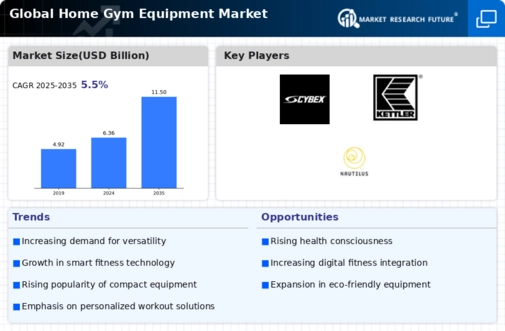Market Analysis
In-depth Analysis of Home Gym Equipment Market Industry Landscape
The home gym equipment market is influenced by a variety of factors that have contributed to its significant growth and popularity in recent years. One of the primary drivers of this market is the increasing focus on health and fitness among consumers. With growing awareness of the importance of regular exercise for overall well-being, more people are seeking convenient ways to incorporate fitness into their daily routines. Home gym equipment offers individuals the flexibility to exercise at any time and in the comfort of their own homes, eliminating the need for costly gym memberships and commuting to fitness centers. As a result, the demand for home gym equipment continues to rise, driving market expansion.
Technological advancements in fitness equipment have played a crucial role in shaping the home gym equipment market. Manufacturers are continually developing new and innovative products that offer enhanced functionality, performance tracking, and interactive features. Smart home gym equipment equipped with built-in screens, connectivity options, and virtual training programs provide users with personalized workout experiences and real-time feedback on their progress. Additionally, advancements in materials and engineering have resulted in more compact, space-saving designs that are suitable for home use, further driving consumer interest and demand for home gym equipment.
Changing consumer lifestyles and preferences have also influenced the home gym equipment market. As people lead increasingly busy and hectic lives, many individuals prioritize convenience and flexibility when it comes to fitness. Home gym equipment allows users to exercise on their own schedule, without the constraints of gym hours or crowded fitness facilities. Moreover, as concerns about personal hygiene and safety have heightened in the wake of the COVID-19 pandemic, more consumers are opting to invest in home gym equipment as a safer alternative to public gyms, further driving market growth.
Distribution channels play a crucial role in the home gym equipment market, with various avenues available for consumers to purchase products. While traditional retail outlets such as sporting goods stores, department stores, and specialty fitness retailers carry home gym equipment, online channels have become increasingly prominent. E-commerce platforms offer consumers a convenient way to browse a wide range of home gym equipment brands, compare prices, read reviews, and make purchases from the comfort of their homes. Additionally, direct-to-consumer brands and subscription-based services provide consumers with curated selections of home gym equipment, further driving market accessibility and convenience.
Price competitiveness is another important market factor in the home gym equipment industry. Home gym equipment is available at various price points to cater to different consumer budgets and preferences. While some consumers may be willing to invest in premium home gym equipment with advanced features and technology, others may opt for more affordable options that provide basic workout functionality. Promotional activities such as discounts, sales, and bundle offers also influence purchasing decisions and stimulate demand in the market. Moreover, as consumers increasingly prioritize value for money and seek products that offer long-term durability and performance, manufacturers are focusing on offering high-quality home gym equipment at competitive prices to maintain market share.
Consumer preferences for specific types of workouts and fitness trends also impact the home gym equipment market. As trends such as high-intensity interval training (HIIT), strength training, and functional fitness gain popularity, consumers seek equipment that supports these workout modalities. Home gym equipment such as treadmills, stationary bikes, elliptical trainers, and weightlifting equipment cater to diverse fitness preferences and goals, allowing users to create personalized workout routines tailored to their needs. Additionally, as more people seek holistic approaches to fitness that incorporate elements of mindfulness and recovery, equipment such as yoga mats, foam rollers, and massage tools also experience increased demand, further driving market growth.
In conclusion, the home gym equipment market is influenced by a combination of factors including consumer demand for convenience, technological advancements, changing lifestyles, distribution channels, price competitiveness, and consumer preferences for specific fitness trends. As consumers continue to prioritize health and fitness and seek convenient ways to exercise at home, the demand for home gym equipment is expected to continue growing. Manufacturers and retailers that understand and respond to these market factors will be well-positioned to capitalize on opportunities for growth and innovation in the dynamic home gym equipment market.

















Leave a Comment